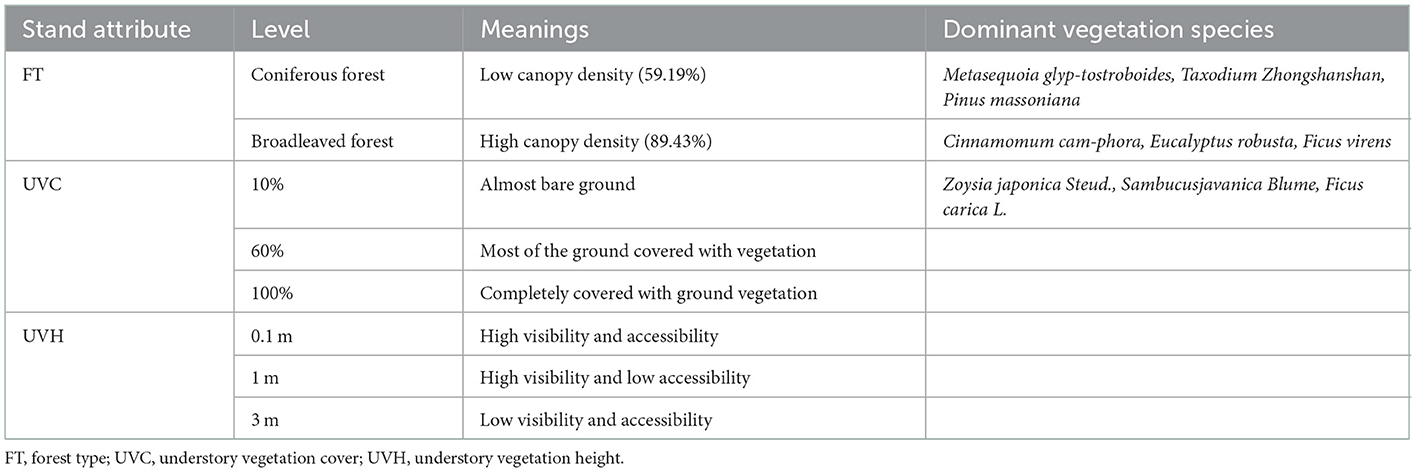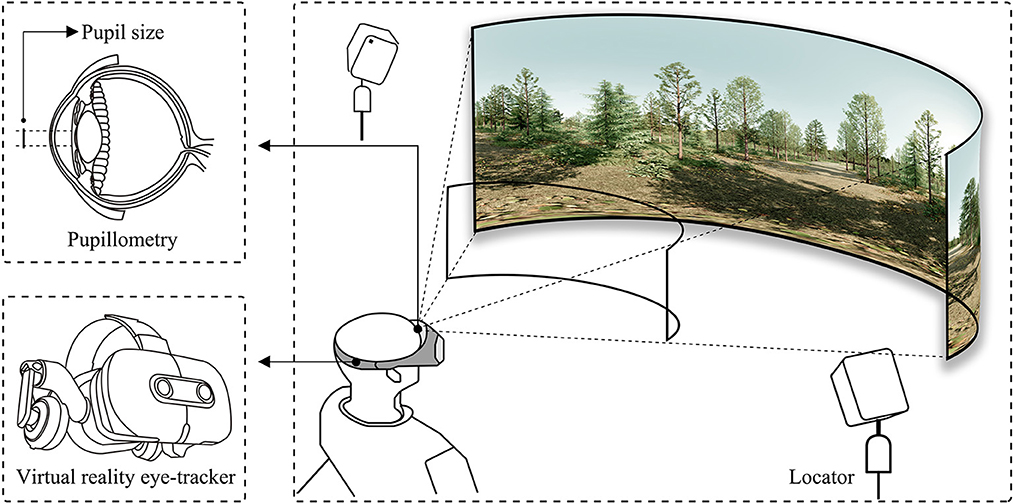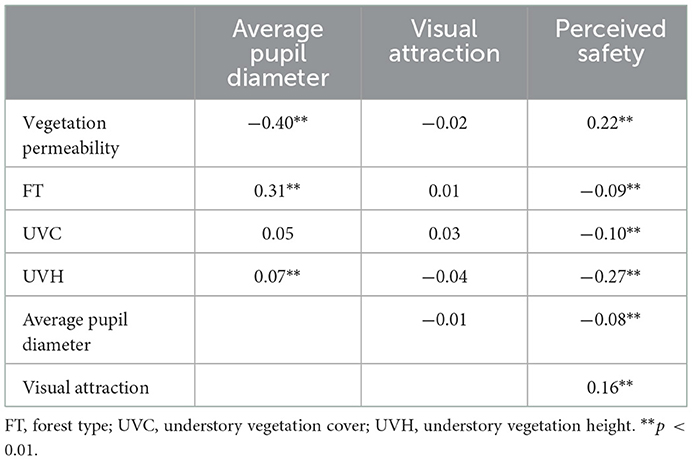- 1School of Architecture and Urban Planning, Suzhou University of Science and Technology, Suzhou, China
- 2Key Laboratory of New Technology for Construction of Cities in Mountain Area, Ministry of Education, Chongqing University, Chongqing, China
- 3School of Architecture and Urban Planning, Chongqing University, Chongqing, China
Previous studies have confirmed the significant effects of single forest stand attributes, such as forest type (FT), understory vegetation cover (UVC), and understory vegetation height (UVH) on visitors' visual perception. However, rarely study has yet clearly determined the relationship between vegetation permeability and visual perception, while the former is formed by the interaction of multiple forest stand attributes (i.e., FT, UVC, UVH). Based on a mixed factor matrix of FT (i.e., coniferous forests and broadleaf), UVC level (i.e., 10, 60, and 100%), and UVH level (0.1, 1, and 3 m), the study creates 18 immersive virtual forest videos with different stand attributes. Virtual reality eye-tracking technology and questionnaires are used to collect visual perception data from viewing virtual forest videos. The study finds that vegetation permeability which is formed by the interaction effect of canopy density (i.e., FT) and understory density (i.e., UVC, UVH), significantly affects participant's visual perception: in terms of visual physiology characteristics, pupil size is significantly negatively correlated with vegetation permeability when participants are viewing virtual reality forest; in terms of visual psychological characteristics, the understory density formed by the interaction of UVC and UVH has a significant impact on visual attractiveness and perceived safety and the impact in which understory density is significantly negatively correlated with perceived safety. Apart from these, the study finds a significant negative correlation between average pupil diameter and perceived safety when participants are viewing virtual reality forests. The findings may be beneficial for the maintenance and management of forest parks, as well as provide insights into similar studies to explore urban public green spaces.
1. Introduction
Urban forest plays an important role in public health. Numerous studies in Asia, Europe, and North America have shown that forest environments provide individuals with health benefits by stimulating the senses such as vision, hearing, and smell (1–3). Therefore, forest therapy has become a preventive medicine measure to strengthen the immune system and improve mental health (4–6). In terms of physical health, exposure to forest environments can bring about cardiorespiratory fitness (2, 7), prevention of cardiovascular disease (1, 8), and anti-inflammatory benefits (9). In terms of mental health, forest environments can help promote physiological relaxation (10), reduce anxiety, depression, and stress (11–13), as well as relieve fatigue, and arouse positive emotions (14–16).
In recent years, to verify the potential benefits of forests in health promotion and disease prevention, an increasing number of studies address the visitors' experience of sit-down and walking behaviors in the forest, namely Shinrin-yoku (1–3). Most of them focus on cognitive preferences which are brought about by tourists' visual experience and investigate a wide range of forest variables, especially the physical environment features such as stand structure (10, 17), canopy density (18, 19), tree cover density (20), openness-enclosure (21, 22), vegetation density (23, 24), and species composition (25). These surveys are designed to assess the stand structure features of the forest that visitors liked and disliked through visual variables, and the results indicate that physical structural features of the forest influence visitors' visual environmental preferences (22, 26, 27). For example, natural, vibrant, and plant-rich forests are more favored than human-induced or damaged forests (22, 26, 27), and the increase in forest stand density was significantly negatively associated with the decrease in anxiety, anger, and other negative emotions (6). The high-density canopy density induces a sense of gloom, and it limits visitors' immersion as people feel unsafe in the forest without sunlight (17). Similarly, the overgrowth of vegetation creates a sense of danger even while blocking the view of people and providing a sense of privacy (20, 26, 28). These findings confirm the classical environmental preference theory, such as Attention Restoration Theory (29), Preference Matrix (29), Stress Reduction Theory (30), Biophilia Hypothesis (31), Prospect-refuge Theory (32), and Supportive Environment Theory (33). These studies confirm that visual perception is one of the most important mediating variables of forest stand that influences visitors' willingness to visit and their evaluation. There is, however, no general agreement among researchers regarding the specifics behind the relationship between tree density and preference. The relationship between tree/vegetation density and preference is usually viewed as linear, some have described it as a power curve (21), while others found it to be quadratic (5). Due to these disagreements, it is difficult to apply our experiment results directly into forest parks improvement. So far, a lack of standardized measures has plagued most forest visual environment measurements. For example, landscape elements measured in 2D images cannot accurately reflect the 3D scene where multiple stand attributes interact, and it is not accurate to measure the vegetation permeability degree in a natural forest through a questionnaire survey of visual perception.
In addition, no consensus has been reached yet on how to present the environ-mental stimuli of the forest and test visual preference. The majority of visual preference studies are conducted in real forests environments since they offer a vivid and realistic view of the forest, however, the results may be affected by temperature, weather, and other perceptions (e.g., sound, smell) as well (12, 22, 34). Many other studies use 2D pictures and 2D video eye-tracking in the laboratory to simulate forest stimuli, which can record the eye movements and gaze of the participants when observing, and analyze the visual exploration mode and preference (35, 36). Although this laboratory method has the advantage of eliminating environmental interference, the feeling of immersion is weaker than the on-site experience, and the interaction with the forest environment is also limited by the absence of presence (37). Immersive Virtual Environment (IVE) device, as an emerging technology, provides a Virtual Reality (VR) experience that is compatible with the advantages of real (immersion and presence) and laboratory experiments (environmental variable controlled) to simulate the interaction between visitors and the forest environments (38–40). Recently, a lot of studies have verified the effectiveness of IVE in simulating real nature (3, 41), including the effect of a virtual forest environment on emotion regulation (42), stress recovery (43), and psychological restorative (44, 45).
Limited by the technical integration, rarely study on forest visual perception has combined the advantages of eye-tracking technology and IVE real-world simulation to discuss how vegetation permeability, which is formed by the interaction of multiple forest stand attributes, affect visitors' visual preference. The present study aims to add new insights to forest preference research, as well as to explore the application of VR eye-tracking technology in forest visual preference research. The specific objectives are the following:
1. Visual behavior characteristics of different vegetation permeability in VR forest exposure;
2. Psychological cognitive evaluation of different vegetation permeability in VR forest exposure;
3. The relationship between vegetation permeability, visual behavioral characteristics, and psychological cognitive evaluation.
2. Materials and methods
2.1. Study site and stimuli
Three subjective parameters include a location (longitude: 31.24628727, latitude: 120.58306217), time (12 am, 20 August 2019), and weather conditions (sunny) are set by virtual reality simulation software (Mars 2019, Sheencity Technology Ltd.) to define the virtual forest environmental attributes and regional plants, and a 10-hectare VR forest is created as experimental area. According to the classifying standards of the upper vegetation, stand attributes, and attribute levels in previous forest scene studies (6, 17, 27), the common coniferous and broadleaved forest scenes in southwest China are selected as stimuli. Each forest scene is set up with a stand density of 320 trees per hectare, this density value has been proven to be useful in facilitating visual access and promoting emotional and cognitive recovery (6, 17). The ground covering of forest scenes consists of under herbs, and undershrub, it includes two visual factors of UVC (level range: 0, 60, 100%) and UVH (level range: 0.1, 1, 3 m), as well as three different factor levels (Table 1; Figures 1, 2). These indicators are related to visual access and perception (20, 27, 46, 47). Since this study focuses on visual perception, other factors which may affect the validity of the experiment, such as water bodies, animals, recreational facilities, forest visitors, and traces of management, are excluded.
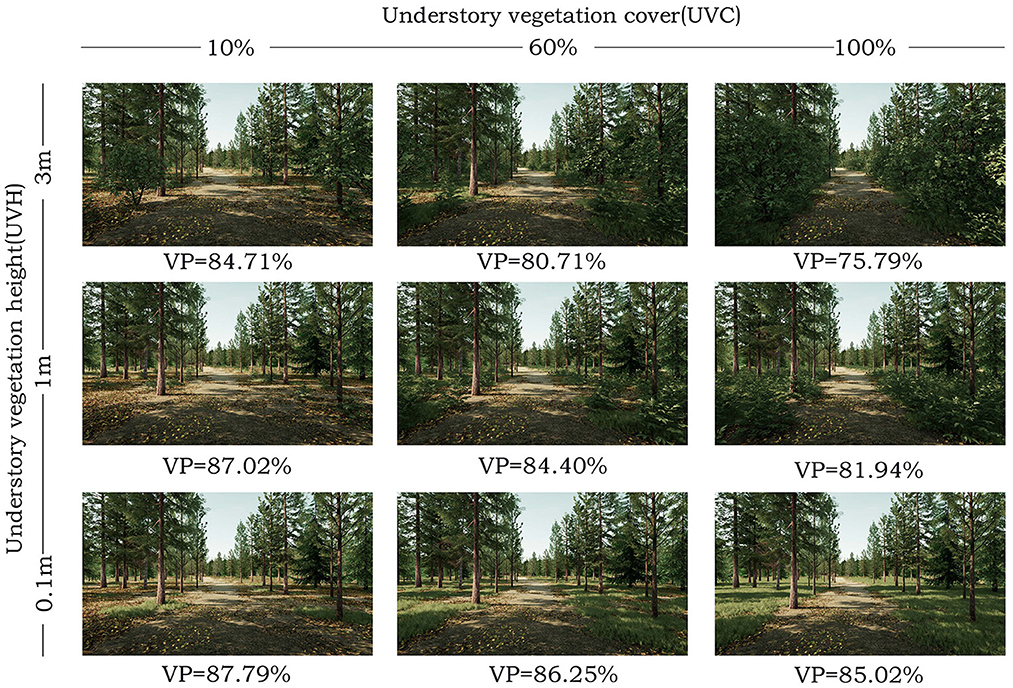
Figure 1. Research stimulus of coniferous forest in the virtual reality video display. VP, vegetation permeability.
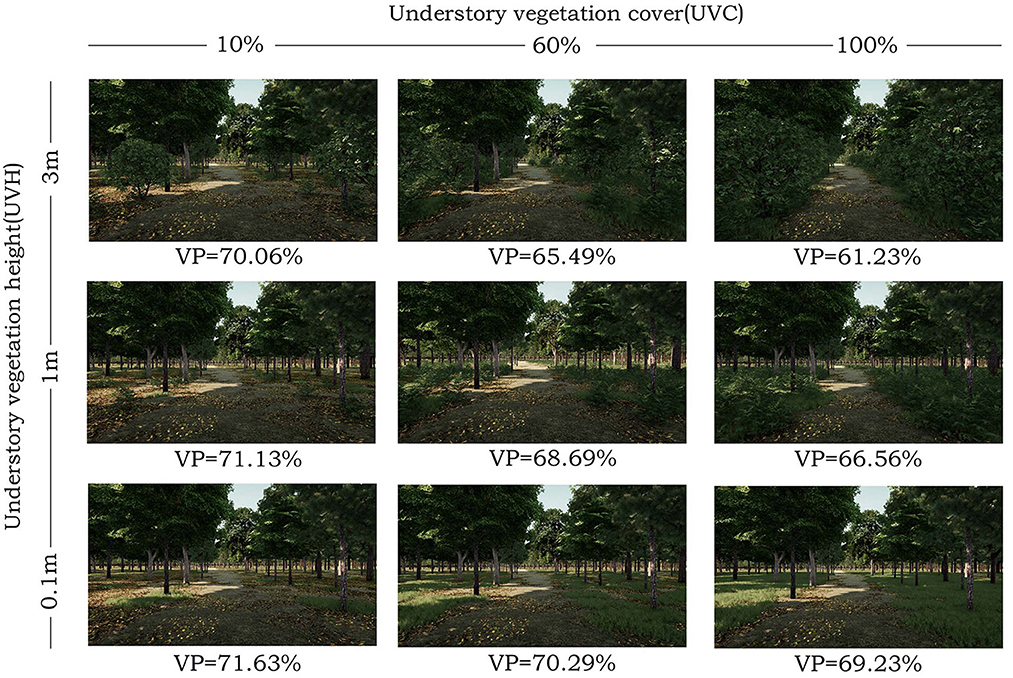
Figure 2. Research stimulus of broadleaved forest in virtual reality video display. VP, vegetation permeability.
Many studies quantify the landscape elements of 2D pictures to distinguish the differences between landscape elements in different scene types (20, 54). Based on these studies, the Boolean operation of SketchUp 2021 (Trimble Inc.) is used to calculate the vegetation permeability degree in 3D forest video. Firstly, it describes and calculates the volume with dominant vegetation species (i.e., tree and ground covering) in the VR forests scene; secondly, it subtracts the vegetation volume from the total volume; and finally, it calculates the index of vegetation permeability (Figure 3). The vegetation permeability of coniferous forests is 75.79–85.02% (Figure 1), while that of the broadleaved forest is 61.23–69.23% (Figure 2). The formula is as follows:
When compared to static stimuli, dynamic stimuli can generate more natural viewing behaviors (48), so we simulate the exposure of individuals while walking in the forest instead of sitting. As shown in Figure 4, we render 18 VR walking-simulated videos with different vegetation permeability but the same walking route and imitate the usual walking speed of adults (78–90 m/min).
2.2. Participants
To obtain a homogeneous sample to calibrate the method, we recruit 60 college students on campus social platforms, 14 of them are excluded due to the time conflict. 46 college students participate in the experiment, including 23 males and 23 females, aged between 19 and 27 (M = 23.33, SD = 1.96). Previous studies have shown that visitors aged between 18 and 35 are the main participants in forest park tourism (49), and college students are regarded as representative and convenience sample groups in visual stimuli research (50). All participants are Han people living in Southeast China, and no forestry major student participated for avoiding bias in preferences and perceptions of forests. Besides, none of them has any visual impairment or problem that may affect data collection. The results of the calculation with G-power version 3.1.9.2 highlight a study size of 36 each group [effect size d = 0.5, β = 0.05, and power (1–β) = 0.95].
2.3. Apparatus
A head-mounted virtual reality eye-tracker (Ergo VR, Kingfar Inc.), with head-mounted display (VIVE Pro, HTC Inc.), tracking frequency (120 Hz) and tracking range (≥120°), is employed to record eye movements. It is equipped with a test main-frame computer (Windows 10, Intel Core i9 CPU @ 3.6GHz, 64-bit, Nvidia GeForce RTX 2080Ti, 32 GB RAM) and two external lighthouses for tracking head position. By integrating virtual reality and eye-tracking into the head-mounted display. When the participants are freely viewing virtual scenes, their eyes and head move simultaneously. This makes researchers capture and record more natural visual behaviors than in experimentally controlled virtual environments (51, 52).
2.4. Experimental design
The study is performed in a quiet eye-tracking laboratory with room temperature constantly maintained at 25°C. Each experiment takes about 40 min, the details are as follows (Figure 5).
First of all, the participants are asked to wear a VR eye tracker of head-mounted which calibrates eye movements by repeated measurements of their eyes by infrared light reflection. After calibration, they turn to watch a 60 s test video to adapt to the VR viewing mode, during which researchers introduce the experiment procedures and precautions. Subsequently, 18 virtual reality videos are randomly presented on the display screen of the VR eye tracker, each target video is about 20 s, and the blank video was spaced 3 s. The participants are free to move their eyes and head to watch the videos during the experiment, and they could withdraw from the experiment at any time if they feel uncomfortable. This part of the experiment mainly obtains the visual physiological data of the participants when viewing different VR forest videos, especially the average pupil diameter (Figure 6). Average pupil diameter records the aver-age pupil size change of participants in each VR forest video. In previous studies, it has often been regarded as a predictor of emotional arousal and autonomic activation (53–55). In fact, a dilator stimulation or a constrictor inhibition can cause pupillary dilation. Its average size in standard light conditions is about 3 mm (56). And in dim light or darkness, the pupil can enlarge to an average size of about 7 mm (57). Cognitively driven changes are usually smaller and rarely exceed 0.5 mm (58).
Eye-tracking data can measure participants' visual physiological indicators but is unable to distinguish specific visual psychological characteristics. Therefore, after the eye-tracking experiment, the participants are asked to fill in demographic information (gender, age, educational level) and forest visit information (visit frequency, visit duration), and then display 18 virtual reality videos randomly again for evaluation. The relationship between the physical environment and visual preferences has been demonstrated in previous studies (59–61), and we select indicators of visual attractiveness and perceived safety to collect their visual psychological data. Between them, visual attraction is used to assess the perceived fascinating of visual environments (59), and perceived safety is often used to assess the perceived threat of the environment (8, 60). The primary sources of threat are social incivilities (e.g., physical or sexual assault), whereas in natural areas there are additional threats (e.g., predators, snakes, spiders). Each item is assessed by a 5-point Likert scale (“not at all” to “very much”).
2.5. Analysis and statistics
We process the eye movement data through the eye-tracking software Ergo LAB (Kingfar Inc.), and the data analysis and psychological perception evaluation are con-ducted by SPSS 24.0 (IBM Inc.). First of all, we calculate the vegetation permeability of 18 VR videos with different stand attributes. Second, calculate the descriptive statistics including mean values and standard deviation for average pupil diameter, fascination, and perceived safety scores in different forest stand attributes. Third, assess the main effects of forest type (within-participants factor: coniferous forests and broadleaf forests), UVC levels (within-participants factor: 10, 60, 100%), and UVH levels (with-in-participants factor: 0.1, 1, 3 m), a three-factor mixed-design analysis of ANOVA is also conducted; besides, Box's M test is used to examine the homogeneity of co-variance assumption in all ANOVA models. For repeated measures with sphericity, Greenhouse Geisser (GG) correction is applied, and the effect size is calculated by partial Eta squared. Fourth, Tukey's HSD is performed to examine how forest type, UVC, and UVH affect average pupil diameter, the scores for fascination, and perceived safety separately between each level. Fifth, The Kendall and Spearman rank correlation is used to analyze correlations between vegetation permeability and participants' visual perception. Partial Eta squared is adopted to calculate the effect size (Figure 7). Significance is established at p < 0.05*, p < 0.01**.
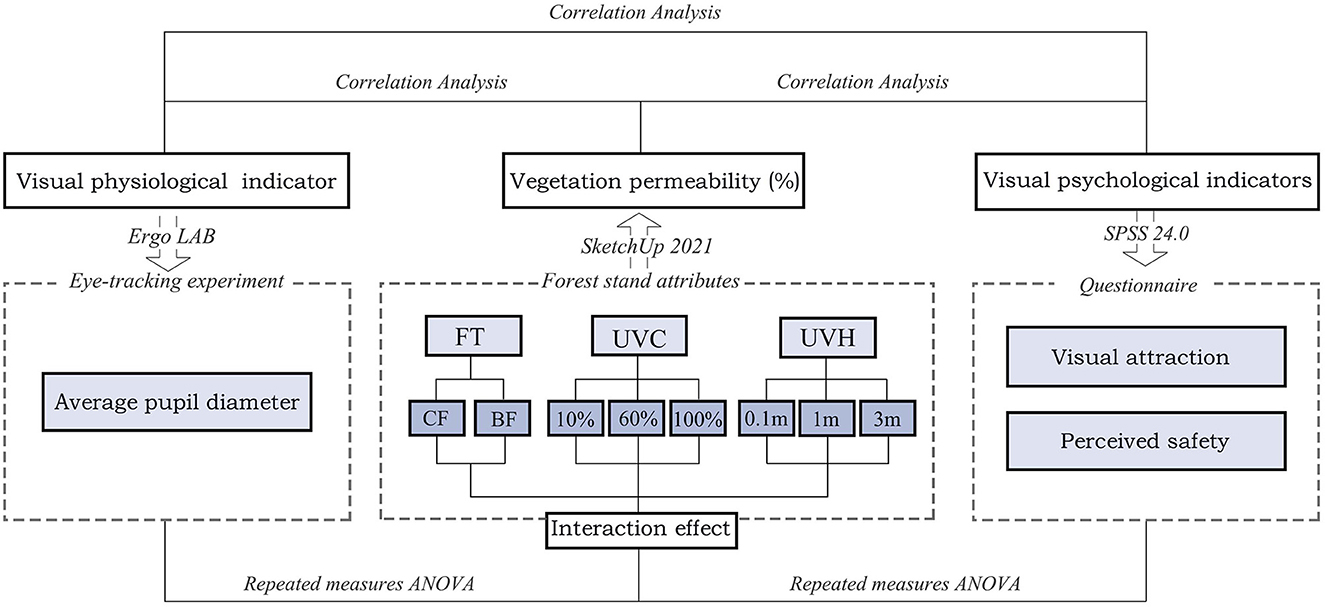
Figure 7. Research framework. FT, forest type; UVC, understory vegetation cover; UVH, understory vegetation height; BF, broadleaved forest; CF, coniferous forest.
3. Results
3.1. Effects of vegetation permeability on average pupil diameter of participants
The results of the ANOVA test reveal the main significant effects of forest type on participant's average pupil diameter [F(1, 826) = 147.89, p < 0.01, ηp2 = 0.15], and indicate that viewing broadleaf forests has a higher average pupil diameter than viewing coniferous forests. Similarly, UVH has a significant main effect on average pupil diameter [F(2, 825) = 3.57, p < 0.05, ηp2 = 0.01], and that viewing 100% UVH has higher average pupil diameter than viewing 10% (p < 0.05; Tables 2, 3).
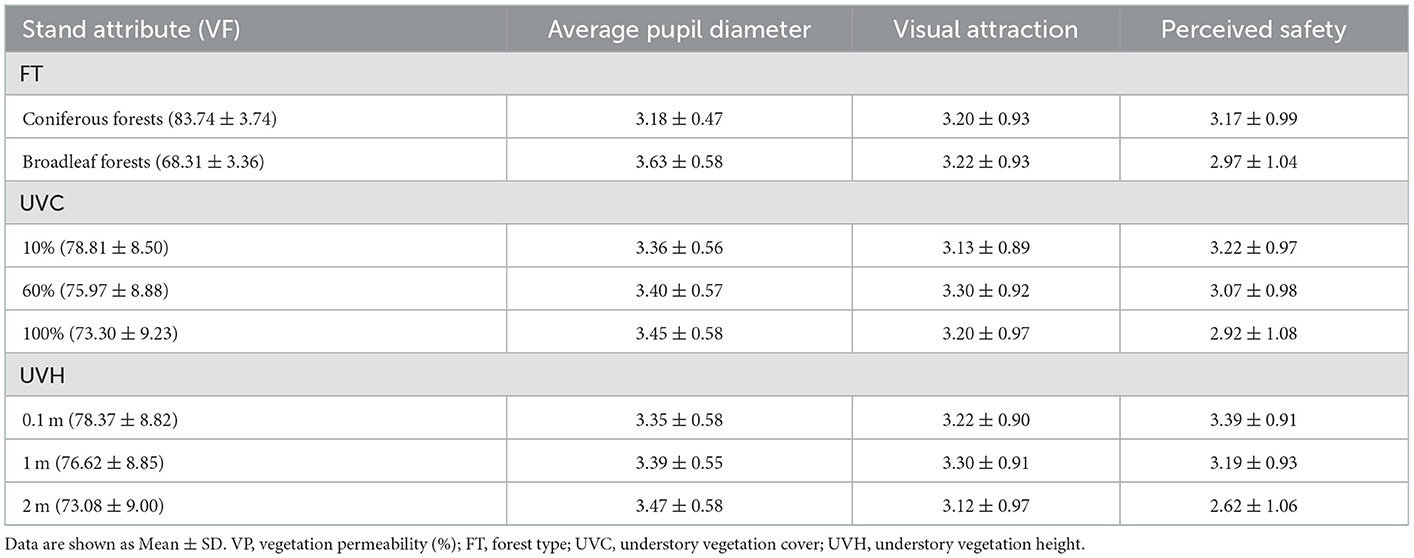
Table 2. Descriptive statistics for average pupil diameter, the scores of visual attraction and perceived safety.
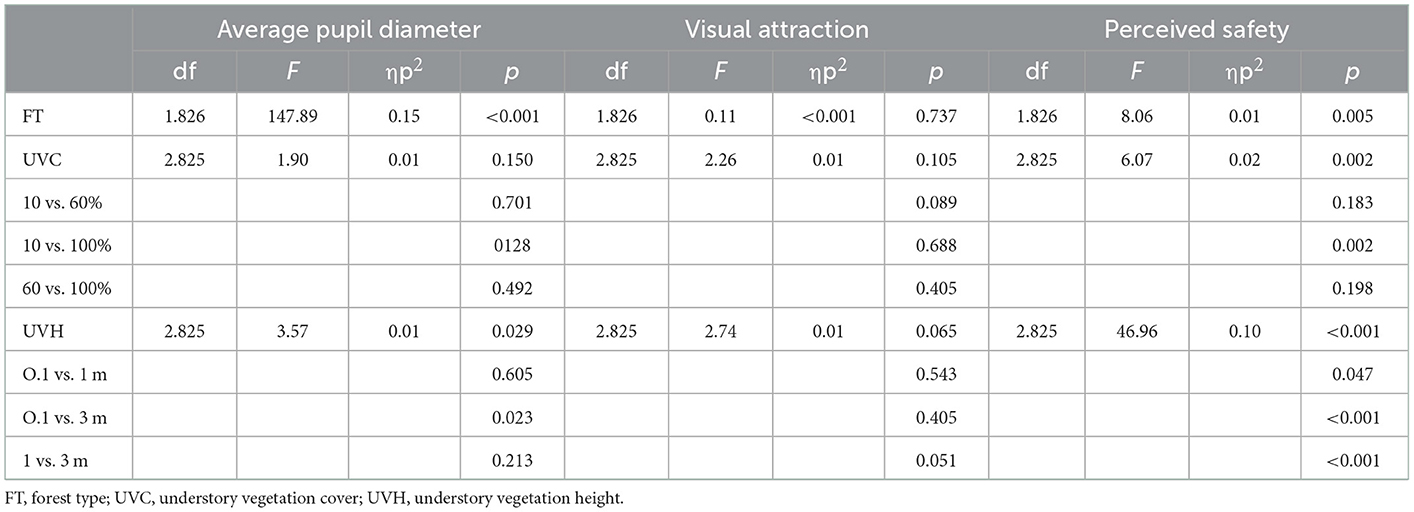
Table 3. ANOVA analysis for average pupil diameter, the scores of visual attraction, and perceived safety.
Significant interaction effect has been found between UVC and UVH [F(4, 540) = 5.51, p < 0.01, ηp2 = 0.04; Figure 8]. Tukey's HSD post-hoc analysis indicates that 100% UVC with 1 m UVH on average pupil diameter is higher than 10% (p < 0.01) and 60% at the same height (p < 0.01), and the average pupil diameter of different UVC with 3 m UVH is significantly different, namely, 10 vs. 60% (p < 0.01), 10 vs. 100% (p < 0.01), 60 vs. 100% (p < 0.01; Figure 8). Additionally, when both forest types are considered, a significant interaction difference has been found between UVC and UVH [F(2, 540) = 2.77, p < 0.03, ηp2 = 0.02]; Tukey's HSD post-hoc analysis indicates that, for the participants, the average pupil diameter of viewing nine coniferous forest scenes is significantly smaller than viewing broadleaved forest (all p < 0.01) with the same UVC and UVH indicators (Figure 9).
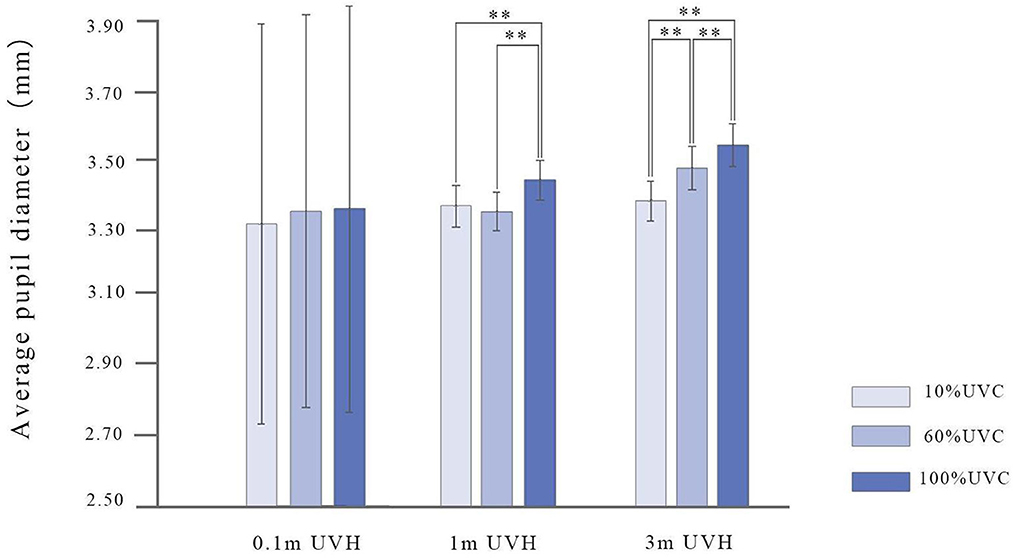
Figure 8. The interaction of UVC and UVH on average pupil diameter. UVC, understory vegetation cover; UVH, understory vegetation height. **p < 0.01.
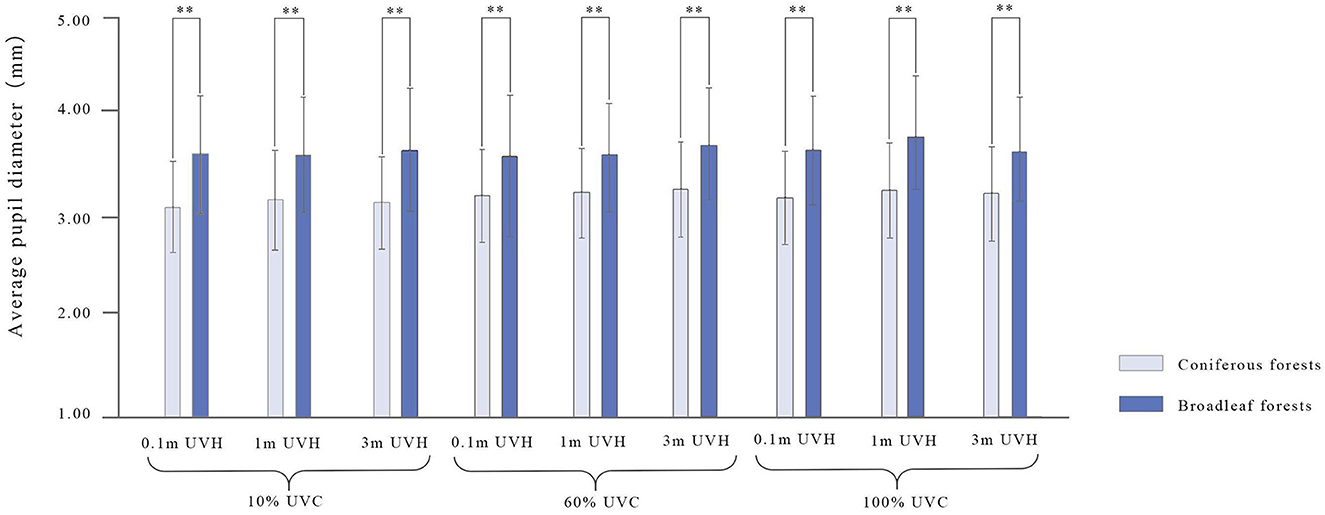
Figure 9. The interaction difference of UVC and UVH on average pupil diameter in two forest types. UVC, understory vegetation cover; UVH, understory vegetation height. **p < 0.01.
3.2. Effects of vegetation permeability on visual attraction
The results of the ANOVA test indicate that no significant main effect of the three forest stand attributes (FT, UVC, and UVH) has been found on participant's visual at-traction (Tables 2, 3), but significant interaction effect exits between UVC and UVH [F(4, 540) = 6.82, p < 0.01, ηp2 = 0.05; Figure 10]. Tukey's HSD post-hoc analysis shows that the effect of 10% UVC with 0.1 m UVH on visual attraction is significantly lower than 60% (p < 0.05) and 100% (p < 0.01) at the same height, the effect of 10% UVC with 1 m UVH on visual attraction is significantly lower than 60% (p < 0.01) and 100% (p < 0.05), and the effect of 100% UVC with 3 m UVH on visual attraction is significantly lower than 10% (p < 0.01) and 60% (p < 0.01) (Figure 10).

Figure 10. The interaction of UVC and UVH on visual attraction. UVC, understory vegetation cover; UVH, understory vegetation height. *p < 0.05; **p < 0.01.
3.3. Effects of vegetation permeability on perceived safety
The results of the ANOVA test reveal the main significant effects of forest type on participant's perceived safety [F(1, 826) = 8.06, p < 0.01, ηp2 = 0.01], and indicate that viewing coniferous forests has higher perceived safety than viewing broadleaved forests. Similarly, UVC has significant main effect on perceived safety [F(2, 825) = 60.71, p < 0.01, ηp2 = 0.02], and the results show that viewing 10% UVC has higher perceived safety than 100% (p < 0.05). In addition, UVH also has a significant main effect on perceived safety [F(2, 825) = 46.96, p < 0.01, ηp2 = 0.10], specifically, viewing 0.1 m UVH has higher perceived safety than viewing 1 m (p < 0.05) and 3 m (p < 0.01), and viewing 1 m has higher perceived safety than 3 m (p < 0.01) (Tables 2, 3).
Significant interaction effect has been found between UVC and UVH [F(4, 540) = 3.37, p < 0.01, ηp2 = 0.02; Figure 11]. Tukey's HSD post-hoc analysis indicates that 100% UVC with 1 m UVH on perceived safety is significantly lower than 10% (p < 0.05) and 60% (p < 0.05) at the same height, and the perceived safety of different UVC at 3 m UVH is significantly different, namely, 10 vs. 60% (p < 0.05), 10 vs. 100% (p < 0.01), 60 vs. 100% (p < 0.05) (Figure 11).
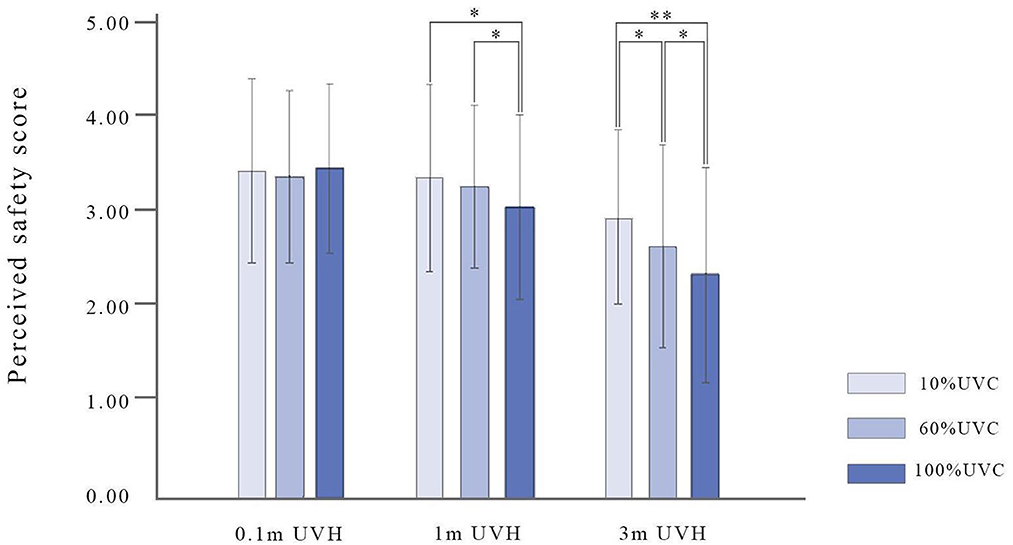
Figure 11. The interaction of UVC and UVH on perceived safety. UVC, understory vegetation cover; UVH, understory vegetation height. *p < 0.05; **p < 0.01.
3.4. Correlation between vegetation permeability and participant's visual perception
Table 4 shows the correlations between vegetation permeability and some participants' visual perceptions. The vegetation permeability is strongly negatively related to average pupil diameter (r = −0.40, p < 0.01), and strongly positively related to perceived safety (r = 0.22, p < 0.01). In contrast, the forest type is strongly positively related to average pupil diameter (r = 0.31, p < 0.01) and strongly negatively related to perceived safety (r = −0.09, p < 0.01). UVC level is strongly negatively related to perceived safety (r = −0.10, p < 0.01). UVH level is strongly positively related to average pupil diameter (r = 0.07, p < 0.01) and strongly negatively related to perceived safety (r = −0.27, p < 0.01).
Besides, a Spearman rank order correlation analysis has also been performed to test the association between eye movement indicators and psychological perception evaluation indicators of participants. Table 4 shows the significant correlations be-tween perceived safety and other indicators, that is, perceived safety is strongly negatively related to average pupil diameter (r = −0.08, p < 0.01) and strongly positively related to a visual attraction (r = 0.16, p < 0.01).
4. Discussion and limitations
4.1. Discussion
In general, the results of VR eye-tracking and questionnaires have supplemented the thematic literature on forest stand attributes and perceived preferences (6, 10, 17, 20, 59, 62). Through VR simulation, vegetation permeability calculation, and immersive viewing experiments, the study draws out a principal finding that when viewing VR forests with different stand attributes,3D vegetation permeability [which is formed by the interaction effect of canopy density (FT) and understory vegetation density (UVC × UVH)] significantly affects participants' visual perception of visual physiological and visual psychological responses.
In addition, the study explores the effect of different vegetation permeability on the visual physiology of the participants, and the results indicate that pupil size is significantly correlated to the permeability of the forest environment, specifically, the lower the permeability of the forest environment, the larger the average pupil diameter. The study also confirms that the average pupil diameter, which reflects the visual physiological stress level, becomes larger when the participants are viewing forest scenes with high canopy density (e.g., broadleaved forest), low visibility, and ground accessibility than viewing forest scenes of low canopy density (e.g., coniferous forest), high visibility and ground accessibility. Two explanations can be put forward for these results. On the one hand, the illumination of closed forest stand attributes is at a low level and requires participants to dilate their pupils to adapt to the dark environment. On the other hand, the atmosphere of the closed forest stand attribute seems potentially threatening, and it may arouse the visual vigilance of the participants to identify possible threats. Previous studies in the restorative environment also confirm that pupil dilation is associated with arousal (53, 54).
Another noteworthy finding is about vegetation permeability and psychological perception evaluation in virtual forest environments. In terms of visual attractiveness, the understory density which is qualified by the interaction of UVC and UVH affects visual attractiveness significantly (Table 2), but the stand attribute variables (FT, UVC, and UVH) are not significantly correlated to visual attractiveness variables in statistics (Table 3). This difference may be caused by a curvilinear relationship between two variable groups. Visual attractiveness improves with the increase of understory density until a certain threshold is reached, after which the relationship gradually weakens (Figure 5). Thus, preference for visual attractiveness is correlated with moderate understory density, namely, it favors high UVH in low UVC and low UVH in high UVC. These results are in line with many previous works, such as the visitor's preference for forest scenarios with a certain complexity (27, 63, 64), and the inverted-U shape relationship between tree cover density and stress recovery (20, 65).
The results of the study on perceived security indicate that the less vegetation permeability, the lower the visual security score. That is, both the decrease of sky visibility due to the increase of canopy density and the increase of understory density formed by the interaction of UVC and UVH will lead to a decrease in the perceived safety of participants. The findings corroborate previous studies of landscape environment preference. The public prefers a natural environment with a wide view since the openness of the surroundings makes it possible for them to check up (the sky) or down (the ground), which brings them a sense of security (21, 47, 56, 61).
Another important finding is that the average pupil diameter and perceived safe-ty are significantly negatively correlated, which confirms the feasibility of pupil size in predicting visual safety in forest environments. In previous eye-tracking experiments, pupil size is usually used to assess visual recovery in natural or artificial environments (36, 54). In psychological perception evaluation indicators, the study finds a significant positive correlation between visual attraction and perceived safety, which coincides with the earlier findings. Previous evaluations of landscape environment preference have shown that the perceived safety of the natural environment is a prerequisite for attracting visitors and arousing aesthetic pleasure, it is an adaptive mechanism for humans to avoid danger in the evolutionary process (66, 67). Additionally, no correlation has been found between average pupil diameter and visual attraction, which may be attributed to the fact that pupil size cannot be used as a dimension to assess visual attraction.
4.2. Limitations
In the present study, we employ VR eye-tracking technology to explore visual perception in an immersive 3D forest environment. When compared with the experiments adopted in real forests by wearing eye-tracking glasses or viewing forest photos with eye-tracking devices, VR eye-tracking technology has the advantage of simulating and collecting the continuous gaze behavior of participants when they are walking in the forest and eliminating occasional environmental disturbances (such as birds, wind, and light changes). The study has verified the effectiveness of VR eye-tracking technology in VR forest environment from the perspective of visual perception. It is an extension to the previous VR forest environment researches in emotional improvement, stress restorative, and psychological restorative. However, some limitations of experimental design and data analysis need to be considered. Firstly, due to space limitation, vegetation permeability mentioned in this study only includes the interaction effects of three forest stand attributes (FT, UVC, and UVH) and other forest stand attributes, such as stand density, stand area, and tree height (10, 11, 17), will be explored in the future; secondly, it is time-consuming to manually analyze the 3D vegetation permeability data of 18 VR forest panoramic videos. It is necessary to improve analysis efficiency in the future to reduce the workload of researchers; furthermore, the participants are college students, and although scholars in previous studies have indicated that college students are representative samples (49, 50), the demographic characteristics of the participants may influence their perceived preference for the forest stand structure (17, 60). For the participants of the present study, the influence of their age, gender, educational back-ground, and major has not been discussed. Future studies should consider these demo-graphic characteristics.
5. Conclusions
The present study focuses on vegetation permeability which is formed by FT, UVC, and UVH), and how they affect participants' visual perception when viewing a VR forest scene. The results show that vegetation permeability formed by the interactive effect of canopy density (FT) and understory density (UVC × UVH) significantly affects participants' visual perception. In terms of visual physiology characteristics, the pupil size of the participants is significantly correlated to vegetation permeability when they are viewing the VR forest, specifically, the lower the permeability of the forest environment, the larger the average pupil diameter.
In terms of visual psychological characteristics, the understory vegetation density formed by the interaction of UVC and UVH has a significant impact on visual attractiveness and perceived safety, and it is significantly negatively correlated with perceived safety. In addition, the study also finds a significant negative correlation between average pupil diameter and perceived safety, which confirms the usefulness of pupil size in assessing perception safety in a forest environment. These results supplement existing literature on relationships in forest restorative environments.
For the research method, the study pioneers the use of VR eye tracking to explore the visual perception of vegetation permeability and confirms that this technology could be successfully used to collect visual physiology data by viewing forest scenes. Furthermore, the VR forest simulation provides an opportunity to systematically manipulate environmental stimuli for strict experiments which are designed to evaluate the impact of various environmental variables on individual visual physiology and psychology.
The results are also beneficial to forest park practice. When designing or upgrading forest parks, it could be crucial to consider the vegetation permeability, which is the interaction effect of different forest stand attributes on the visual perception of visitors. Last but not the least, the VR eye-tracking and visual assessment methods employed in this study could advance relative urban public space research, as well as provide potential benefits to evaluate the continuous experience of on-site visual perception in other public spaces (e.g., waterfronts, community parks, and street green spaces).
Data availability statement
The raw data supporting the conclusions of this article will be made available by the authors, without undue reservation.
Ethics statement
The studies involving human participants were reviewed and approved by Ethics Committee of Suzhou University of Science and Technology. The patients/participants provided their written informed consent to participate in this study.
Author contributions
CL: conceptualization, methodology, and writing. CD: project administration and funding acquisition. TT: software and visualization. SG: data curation, visualization, validation, and software. All authors contributed to the article and approved the submitted version.
Funding
This research was funded by the Open Fund of Key Laboratory of New Technology for Construction of Cities in Mountain Area (grant number LNTCCMA-20200107), Landscape Architecture as a Key Discipline of the 14th Five Year Plan in Jiangsu, and the Qing Lan Project of Jiangsu.
Acknowledgments
We would like to thank all participants in our trials on our study.
Conflict of interest
The authors declare that the research was conducted in the absence of any commercial or financial relationships that could be construed as a potential conflict of interest.
Publisher's note
All claims expressed in this article are solely those of the authors and do not necessarily represent those of their affiliated organizations, or those of the publisher, the editors and the reviewers. Any product that may be evaluated in this article, or claim that may be made by its manufacturer, is not guaranteed or endorsed by the publisher.
Supplementary material
The Supplementary Material for this article can be found online at: https://www.frontiersin.org/articles/10.3389/fpubh.2023.1089423/full#supplementary-material
References
2. Baran PK, Tabrizian P, Zhai Y, Smith J W, Floyd MF. An exploratory study of perceived safety in a neighborhood park using immersive virtual environments. Landsc Urban Plan. (2018) 35:72–81. doi: 10.1016/j.ufug.2018.08.009
3. Bielinis E, Simkin J, Puttonen P, Tyrväinen L. Effect of viewing video representation of the urban environment and forest environment on mood and level of procrastination. Int J Env Res Public Health. (2020) 17:5109. doi: 10.3390/ijerph17145109
4. Bielinis E, Takayama N, Boiko S, Omelan A, Bielinis L. The effect of winter forest bathing on psychological relaxation of young Polish adults. Urban For Urban Green. (2018) 29:276–83. doi: 10.1016/j.ufug.2017.12.006
5. Bjerke T, Østdahl T, Thrane C, Strumse E. Vegetation density of urban parks and perceived appropriateness for recreation. Urban For Urban Green. (2006) 5:35–44. doi: 10.1016/j.ufug.2006.01.006
6. Bradley MM, Miccoli L, Escrig MA, Lang PJ. The pupil as a measure of emotional arousal and autonomic activation. Psychophysiology. (2008) 45:602–7. doi: 10.1111/j.1469-8986.2008.00654.x
7. Callahan-Flintoft C, Barentine C, Touryan J, Ries AJ. A case for studying naturalistic eye and head movements in virtual environments. Front Psychol. (2021) 12:650693. doi: 10.3389/fpsyg.2021.650693
8. Chiang Y-C, Nasar JL, Ko C-C. Influence of visibility and situational threats on forest trail evaluations. Landsc Urban Plan. (2014) 125:166–73. doi: 10.1016/j.landurbplan.2014.02.004
9. Chiang YC Li DY, Jane HA. Wild or tended nature? The effects of landscape location and vegetation density on physiological and psychological responses. Landsc Urban Plan. (2017) 167:72–83. doi: 10.1016/j.landurbplan.2017.06.001
10. Ciesielski M, Stereńczak K. What do we expect from forests? The European view of public demands. J Environ Manage. (2018) 209:139–51. doi: 10.1016/j.jenvman.2017.12.032
11. Dorr M, Martinetz T, Gegenfurtner KR, Barth E. Variability of eye movements when viewing dynamic natural scenes. J Vision. (2010) 10:28–28. doi: 10.1167/10.10.28
12. Ebenberger M, Arnberger A. Exploring visual preferences for structural attributes of urban forest stands for restoration and heat relief. Urban For Urban Green. (2019) 41:272–82. doi: 10.1016/j.ufug.2019.04.011
13. Edwards DM, Jay M, Jensen FS, Lucas B, Marzano M, Montagné C, et al. Public preferences across europe for different forest stand types as sites for recreation. Ecol Soc. (2012) 17:27. doi: 10.5751/ES-04520-170127
14. Franěk M, PetruŽálek J, Šefara D. Eye movements in viewing urban images and natural images in diverse vegetation periods. Urban For Urban Green. (2019) 46:126477. doi: 10.1016/j.ufug.2019.126477
15. Gao Y, Zhang T, Zhang W, Meng H, Zhang Z. Research on visual behavior characteristics and cognitive evaluation of different types of forest landscape spaces. Urban For Urban Green. (2020) 54:126788. doi: 10.1016/j.ufug.2020.126788
16. Grahn P, Stigsdotter UK. The relation between perceived sensory dimensions of urban green space and stress restoration. Landsc Urban Plan. (2010) 94:264–75. doi: 10.1016/j.landurbplan.2009.10.012
17. Guan H, Wei H, He X, Ren Z, An B. The tree-species-specific effect of forest bathing on perceived anxiety alleviation of young-adults in urban forests. Ann For Res. (2017) 60:327–41. doi: 10.15287/afr.2017.897
18. Gundersen VS, Frivold LH. Public preferences for forest structures: A review of quantitative surveys from Finland, Norway and Sweden. Urban For Urban Green. (2008) 7:241–58. doi: 10.1016/j.ufug.2008.05.001
19. Hegetschweiler KT, Wartmann FM, Dubernet I, Fischer C, Hunziker M. Urban forest usage and perception of ecosystem services – A comparison between teenagers and adults. Urban For Urban Green. (2022) 74:127624. doi: 10.1016/j.ufug.2022.127624
20. Jansson M, Fors H, Lindgren T, Wiström B. Perceived personal safety in relation to urban woodland vegetation – A review. Urban For Urban Green. (2013) 12:127–33. doi: 10.1016/j.ufug.2013.01.005
21. Jiang B, Chang CY, Sullivan WC. A dose of nature: tree cover, stress reduction, and gender differences. Landsc Urban Plan. (2014) 132:26–36. doi: 10.1016/j.landurbplan.2014.08.005
22. Joye Y, van den Berg A. Is love for green in our genes? A critical analysis of evolutionary assumptions in restorative environments research. Urban For Urban Green. (2011) 10:261–8. doi: 10.1016/j.ufug.2011.07.004
23. Kaplan R, Kaplan S. The Experience of Nature: A Psychological Perspective. New York, NY: Cambridge University Press (1989).
24. Kim E, Park S, Kim S, Choi Y, Cho J, Cho S-I, et al. Can different forest structures lead to different levels of therapeutic effects? A systematic review and meta-analysis. Healthcare. (2021) 9:1427. doi: 10.3390/healthcare9111427
25. Korpela K, Savonen EM, Anttila S, Pasanen T, Ratcliffe E. Enhancing wellbeing with psychological tasks along forest trails. Urban For Urban Green. (2017) 26:25–30. doi: 10.1016/j.ufug.2017.06.004
26. Lee J, Park B-J, Tsunetsugu Y, Kagawa T, Miyazaki Y. Restorative effects of viewing real forest landscapes, based on a comparison with urban landscapes. Scand J Forest Res. (2009) 24:227–34. doi: 10.1080/02827580902903341
27. Lee J, Park BJ, Tsunetsugu Y, Ohira T, Kagawa T, Miyazaki Y. Effect of forest bathing on physiological and psychological responses in young Japanese male subjects. Public Health. (2011) 125:93–100. doi: 10.1016/j.puhe.2010.09.005
28. Li C, Sun C, Sun M, Yuan Y, Li P. Effects of brightness levels on stress recovery when viewing a virtual reality forest with simulated natural light. Urban For Urban Green. (2020) 56:126865. doi: 10.1016/j.ufug.2020.126865
29. Li C, Yuan Y, Sun C, Sun M. The perceived restorative quality of viewing various types of urban and rural scenes: based on psychological and physiological responses. Sustainability. (2022) 14:3799. doi: 10.3390/su14073799
30. Li H, Zhang X, Wang H, Yang Z, Liu H, Cao Y, et al. Access to nature via virtual reality: a mini-review. Front Psychol. (2021) 12:725288. doi: 10.3389/fpsyg.2021.725288
31. Li Q, Morimoto K, Kobayashi M, Inagaki H, Katsumata M, Hirata Y, et al. Visiting a forest, but not a city, increases human natural killer activity and expression of anti-cancer proteins. Int J Immunopath. (2008) 21:117–27. doi: 10.1177/039463200802100113
32. Li Z, Sun X, Zhao S, Zuo H. Integrating eye-movement analysis and the semantic differential method to analyze the visual effect of a traditional commercial block in Hefei, China. Front Archit Res. (2021) 10:317–31. doi: 10.1016/j.foar.2021.01.002
33. Lis A, Iwankowski P. Why is dense vegetation in city parks unpopular? The mediative role of sense of privacy and safety. Urban For Urban Green. (2021) 59:126988. doi: 10.1016/j.ufug.2021.126988
34. Luo P, Miao Y, Zhao J. Effects of auditory-visual combinations on students' perceived safety of urban green spaces during the evening. Urban For Urban Green. (2021) 58:126904. doi: 10.1016/j.ufug.2020.126904
35. Mao G, Cao Y, Wang B, Wang S, Chen Z, Wang J, et al. The salutary influence of forest bathing on elderly patients with chronic heart failure. Int J Env Res Public Health. (2017) 14:368. doi: 10.3390/ijerph14040368
36. Mao Gen X, Cao Yong B, Yang Y, Chen Zhuo M, Dong Jian H, Chen Sha S, et al. Additive benefits of twice forest bathing trips in elderly patients with chronic heart failure. Biomed Environ Sci. (2018) 31:159. doi: 10.3967/bes2018.020
37. Morita E, Imai M, Okawa M, Miyaura T, Miyazaki S. A before and after comparison of the effects of forest walking on the sleep of a community-based sample of people with sleep complaints. Bio Psycho Social Med. (2011) 5:13. doi: 10.1186/1751-0759-5-13
38. Mostajeran F, Krzikawski J, Steinicke F, Kühn S. Effects of exposure to immersive videos and photo slideshows of forest and urban environments. Sci Rep. (2021) 11:3994. doi: 10.1038/s41598-021-83277-y
39. Moyle W, Jones C, Dwan T, Petrovich T. Effectiveness of a virtual reality forest on people with dementia: a mixed methods pilot study. Gerontologist. (2017) 58:478–87. doi: 10.1093/geront/gnw270
40. Nielsen AB, Heyman E, Richnau G. Liked, disliked and unseen forest attributes: Relation to modes of viewing and cognitive constructs. J Environ Manage. (2012) 113:456–66. doi: 10.1016/j.jenvman.2012.10.014
41. Nordh H, Hagerhall CM, Holmqvist K. Exploring view pattern and analysing pupil size as a measure of restorative qualities in park photos. Acta Hortic. (2010) 881:767–72. doi: 10.17660/ActaHortic.2010.881.126
42. Park B-J, Furuya K, Kasetani T, Takayama N, Kagawa T, Miyazaki Y. Relationship between psychological responses and physical environments in forest settings. Landsc Urban Plan. (2011) 102:24–32. doi: 10.1016/j.landurbplan.2011.03.005
43. Peterfalvi A, Meggyes M, Makszin L, Farkas N, Miko E, Miseta A, et al. Forest bathing always makes sense: blood pressure-lowering and immune system-balancing effects in late spring and winter in Central Europe. Int J Env Res Public Health. (2021) 18:2067. doi: 10.3390/ijerph18042067
44. Reese G, Stahlberg J, Menzel C. Digital shinrin-yoku: do nature experiences in virtual reality reduce stress and increase well-being as strongly as similar experiences in a physical forest? Virtual Real. (2022) 26:1245–55. doi: 10.1007/s10055-022-00631-9
45. Ross AM, Jones RJF. Simulated forest immersion therapy: methods development. Int J Env Res Public Health. (2022) 19:5373. doi: 10.3390/ijerph19095373
46. Song C, Ikei H, Kobayashi M, Miura T, Li Q, Kagawa T, et al. Effects of viewing forest landscape on middle-aged hypertensive men. Urban For Urban Green. (2017) 21:247–52. doi: 10.1016/j.ufug.2016.12.010
47. Song C, Ikei H, Miyazaki Y. Sustained effects of a forest therapy program on the blood pressure of office workers. Urban For Urban Green. (2017) 27:246–52. doi: 10.1016/j.ufug.2017.08.015
48. Stoltz J, Lundell Y, Skarback E, van den Bosch MA, Grahn P, Nordstrom E-M, et al. Planning for restorative forests: describing stress-reducing qualities of forest stands using available forest stand data. Eur J For Res. (2016) 135:803–13. doi: 10.1007/s10342-016-0974-7
49. Syed Abdullah SS, Awang Rambli DR, Sulaiman S, Alyan E, Merienne F, Diyana N. The impact of virtual nature therapy on stress responses: a systematic qualitative review. Forests. (2021) 12:1776. doi: 10.3390/f12121776
50. Tabrizian P, Baran PK, Smith WR, Meentemeyer RK. Exploring perceived restoration potential of urban green enclosure through immersive virtual environments. J Enviro Psychol. (2018) 55:99–109. doi: 10.1016/j.jenvp.2018.01.001
51. Tomao A, Secondi L, Carrus G, Corona P, Portoghesi L, Agrimi M. Restorative urban forests: Exploring the relationships between forest stand structure, perceived restorativeness and benefits gained by visitors to coastal Pinus pinea forests. Ecol Indic. (2018) 90:594–605. doi: 10.1016/j.ecolind.2018.03.051
52. Tyrväinen L, Ojala A, Korpela K, Lanki T, Tsunetsugu Y, Kagawa T. The influence of urban green environments on stress relief measures: a field experiment. J Enviro Psychol. (2014) 38:1–9. doi: 10.1016/j.jenvp.2013.12.005
53. Tyrväinen L, Silvennoinen H, Kolehmainen O. Ecological and aesthetic values in urban forest management. Urban For Urban Green. (2003) 1:135–49. doi: 10.1078/1618-8667-00014
54. Ugwitz P, Kvarda O, Juríková Z, Šašinka C, Tamm S. Eye-tracking in interactive virtual environments: implementation and evaluation. Appl Sci. (2022) 12:1027. doi: 10.3390/app12031027
55. Ulrich R. View through a window may influence recovery from surgery. Science. (1984) 224:420–1. doi: 10.1126/science.6143402
56. Laeng B, Sirois S, Gredebäck G. Pupillometry: a window to the preconscious? Perspect Psychol. (2012) 7:18–27. doi: 10.1177/1745691611427305
57. MacLachlan C, Howland HC. Normal values and standard deviations for pupil diameter and interpupillary distance in subjects aged 1 month to 19 years. Ophthal Physl Opt. (2002) 22:175–82. doi: 10.1046/j.1475-1313.2002.00023.x
58. Beatty J, Lucero-Wagoner B. The pupillary system. In:Cacioppo JT, Tassinary LG, Berntson G, , editors. Handbook of Psychophysiology. Cambridge, MA: Cambridge University Press (2000). p. 87–106.
59. Ulrich RS. Biophilic theory and research for healthcare design. In:Kellert SR, Heerwagen JH, Mador ML, , editors. Biophilic Design: The Theory, Science, and Practice of Bringing Buildings to Life. Hoboken, NJ: John Wiley, & Sons, Inc. (2008). p. 87–106.
60. Ulrich RS, Simons RF, Losito BD, Fiorito E, Miles MA, Zelson M. Stress recovery during exposure to natural and urban environments. J Enviro Psychol. (1991) 11:201–30. doi: 10.1016/S0272-4944(05)80184-7
61. Wang Y, Jiang M, Huang Y, Sheng Z, Huang X, Lin W, et al. Physiological and psychological effects of watching videos of different durations showing urban bamboo forests with varied structures. Int J Env Res Public Health. (2020) 17:3434. doi: 10.3390/ijerph17103434
62. Wang Z, Li M, Zhang X, Song L. Modeling the scenic beauty of autumnal tree color at the landscape scale: a case study of Purple Mountain, Nanjing, China. Urban For Urban Green. (2020) 47:126526. doi: 10.1016/j.ufug.2019.126526
64. Yu C-P, Lee H-Y, Lu W-H, Huang Y-C, Browning MHEM. Restorative effects of virtual natural settings on middle-aged and elderly adults. Urban For Urban Green. (2020) 56:126863. doi: 10.1016/j.ufug.2020.126863
65. Yu C-P, Lee H-Y, Luo X-Y. The effect of virtual reality forest and urban environments on physiological and psychological responses. Urban For Urban Green. (2018) 35:106–14. doi: 10.1016/j.ufug.2018.08.013
66. Zhang G, Yang J, Wu G, Hu X. Exploring the interactive influence on landscape preference from multiple visual attributes: openness, richness, order, and depth. Urban For Urban Green. (2021) 65:127363. doi: 10.1016/j.ufug.2021.127363
Keywords: vegetation permeability, eye-tracking, visual preference, interaction effect, virtual reality
Citation: Li C, Du C, Ge S and Tong T (2023) An eye-tracking study on visual perception of vegetation permeability in virtual reality forest exposure. Front. Public Health 11:1089423. doi: 10.3389/fpubh.2023.1089423
Received: 04 November 2022; Accepted: 04 January 2023;
Published: 24 January 2023.
Edited by:
Zhonghua Gou, Wuhan University, ChinaReviewed by:
Qinghua Lei, National University of Singapore, SingaporeChen Yang, Tongji University, China
Copyright © 2023 Li, Du, Ge and Tong. This is an open-access article distributed under the terms of the Creative Commons Attribution License (CC BY). The use, distribution or reproduction in other forums is permitted, provided the original author(s) and the copyright owner(s) are credited and that the original publication in this journal is cited, in accordance with accepted academic practice. No use, distribution or reproduction is permitted which does not comply with these terms.
*Correspondence: Chang Li,  bGljaGFuZ0B1c3RzLmVkdS5jbg==; Chunlan Du,
bGljaGFuZ0B1c3RzLmVkdS5jbg==; Chunlan Du,  ZHVjaHVubGFuMjAyMkBzaW5hLmNvbQ==
ZHVjaHVubGFuMjAyMkBzaW5hLmNvbQ==
 Chang Li
Chang Li Chunlan Du2,3*
Chunlan Du2,3*